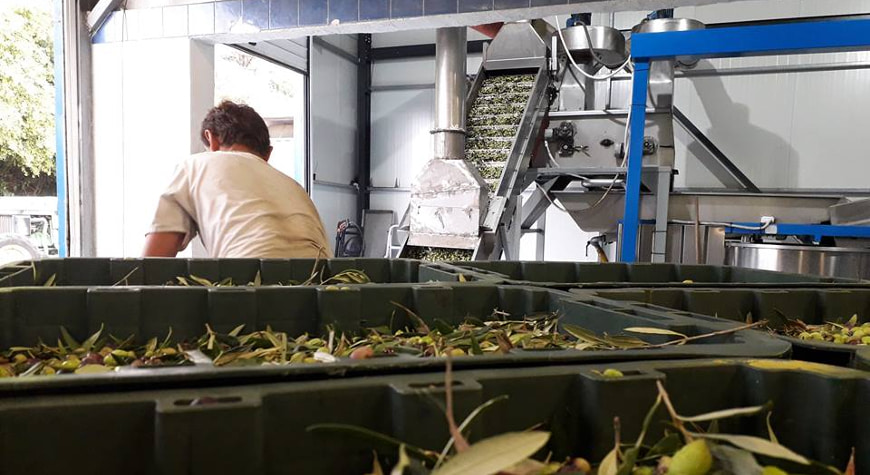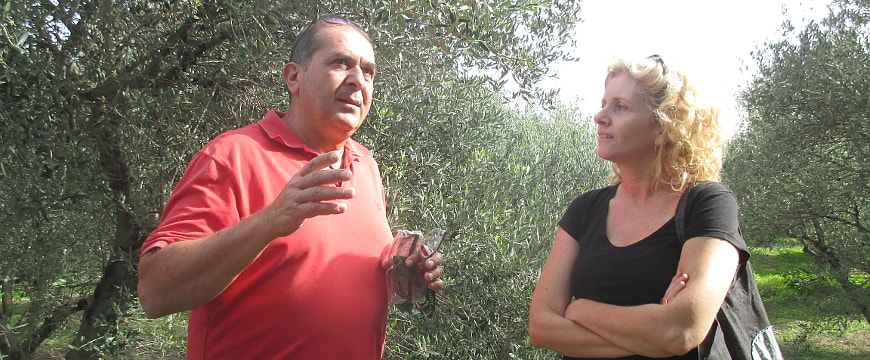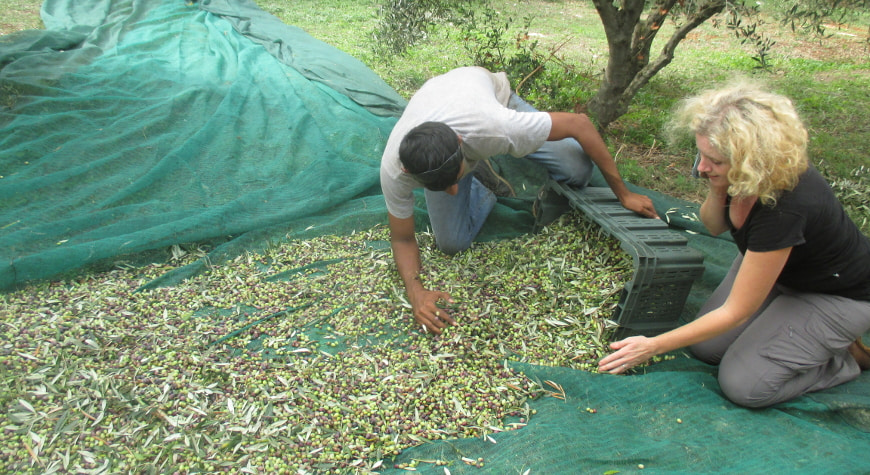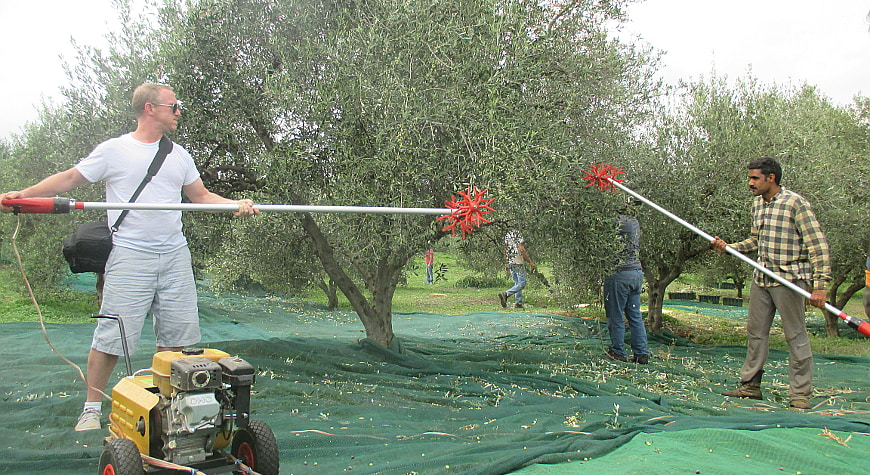How are Greek olives harvested? How is Greek olive oil made? A small international group learned the answers to these questions while enjoying a behind the scenes glimpse of a farmer’s daily life. We participated in the Cretan Gastronomy Center’s olive harvest day, following the Kalligiannis family’s olives from their trees to the village olive mill.
Two Canadians (a photographer and an accountant), two French tour guides, and an American writer met three Greek women and twin three year old girls for a drive along winding rural roads past hills full of olive trees. We followed Kostas Kalligiannis to his family olive grove in Skouloufia, east of Rethymno, where the fruit of 2,000 Koroneiki olive trees is harvested to make their Zero One organic extra virgin olive oil.
Along with his son Antonis and our guide, the Cretan Gastronomy Center’s Aspassia Stavroulaki, Kostas told us about the organic cultivation of his olive grove and the links between the quality of the olive oil and proper cultivation, pest control, pruning, harvesting, milling, and storage practices. Beneath the olive trees, some now denuded of their fruit, others still full of the small, mostly green olives, Kostas explained his use of organic pest control and soil enrichment methods.
Walking through the grove, we found the five Pakistani men who form the harvesting team. Antonis told us they begin harvesting from the inside of each tree and move out, to avoid stepping on the olives, since this fruit is very sensitive. We watched, photographed, and asked questions as the harvesting team efficiently lifted long-handled mechanical harvesters with long “fingers” that whirled around to dislodge olives from the trees. Olives rained down onto the green nets spread over the ground.
As part of the team finished with a tree, another worker lifted a net to shift the olives into a long pile, and then a more compact one. He raked most of the leaves and branches to the side, then pushed the olives into plastic crates with his hand and arm, finally lifting the net to pour in the remaining fruit. The crates are much better for the olives than traditional burlap bags, since they are full of slits that allow air in, and they reduce the premature crushing and heating of olives that can damage the quality of olive oil.
The piles of olives proved too alluring to resist; some of us knelt to pick up handfuls or help push them into their crates. And we photographed the olives wherever we found them: on the nets, in the crates, on the trees—sometimes while dodging flying olives.
We took a break for a traditional Cretan picnic lunch in the shade of the trees, using olive crates as our seats, a picnic blanket as our table, and Kostas’s pickup truck as our kitchen. His wife had kindly provided a big pot of meatballs, cucumber, tomato, graviera cheese, bread, and the makings for dakos: moistened rusks topped with fresh crushed tomato, crumbled feta cheese, and plenty of richly flavorful Zero One extra virgin olive oil. With red wine and raki made from Kostas’s own grapes, guests and hosts enjoyed a leisurely lunch with friendly conversation.
The real harvesters returned to work long before we got up to try harvesting alongside them. That is hard work. None of us visitors lasted more than a few minutes, holding the harvester high above us to reach the olives hanging from branches all over the trees. While some tourists actively participate in harvests for hours and days, that requires a strength and stamina we did not demonstrate on this more relaxed, yet enlightening, outing.
The harvesters continued their work, but we visitors took another break for coffee and raki at a village café in Viran Episkopi, not far from the olive mill. We disussed the efficiency of the harvesters and the beauty of the olives and trees, marveling at the amount of care, fitness, strength, and labor involved in the production of extra virgin olive oil (EVOO). We agreed that EVOO prices tend to be too low, considering the work that goes into it.
In the late afternoon, we all convened at the mill where the Kalligiannis family takes the day’s haul of harvested olives for the immediate oil extraction that yields the best extra virgin olive oil. Their early harvest of mostly unripe green olives—in mid October, not in the more traditional harvest months of November, December, or even later, when the olives are completely ripe and black—also tends to produce higher quality, extra healthy olive oil.
We watched as another farmer’s burlap bags, and later the Kalligiannis family’s crates, were emptied into a hopper. We saw the olives conveyed upward, with remaining leaves sucked up by a vacuum and piped to a huge pile outside. We observed the olives swimming around in a washing machine pool, then receiving a good shower.

After the olives disappeared into stainless steel tubes and machinery for transformation into a paste, Kostas explained the entire production process of this modern mill, which takes 1 to 1 ½ hours: the crushing, churning, and centrifugation in the machinery in front of us. We could see the paste churning in the malaxers, smell the freshness of the olives, and hear the roar of the machines.
This was a glimpse of the everyday life of Cretan farmers. Although we spent too little time actually working to truly experience the difficult challenge of the olive harvest, we observed and learned about the process and appreciated the flavor, sounds, and aroma of rural life as most tourists do not.
Another olive harvest experience would be different, like one year’s wine or olive oil differs from another vintage. Even so, our experience suggests that agrotourism experiences have the potential to help foster international goodwill and intercultural understanding. We ended the day with great respect for olive farmers and olive oil, and with new friends.
_____________________________________
Thanks to the Kalligiannis family for their friendly hospitality and generosity while hosting us in their olive grove, and thanks to Aspassia Stavroulaki at the Cretan Gastronomy Center for organizing the outing and for the photo of the crates of olives in the mill. The Cretan Gastronomy Center serves locals, including schoolchildren, as well as tourists, offering seminars and cooking demonstrations. They hope to organize more olive harvest events in the future. Visit their website for more information.




